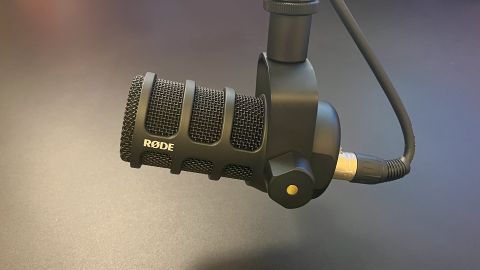GamesRadar+ Verdict
The RODE PodMic USB's dual USB-C and XLR connectivity is seldom found in this market. It makes for a microphone that's as versatile as it is high-quality. For podcasters, streamers, and content creators, this is an excellent tool that will supply you with crisp vocals no matter what device you're recording on.
Pros
- +
XLR or USB output
- +
Crisp, rounded vocals
- +
Onboard Aphex processing
- +
Works with mobile devices
Cons
- -
Heavy
- -
Requires a mic arm or stand
Why you can trust GamesRadar+
The 2023 RODE PodMic USB gives some interesting fuel to the XLR or USB microphone debate that's been longstanding. These days, you'll hear plenty of arguments for and against both, and plenty of options for either if you're shopping around. So if you’re a streamer or podcaster who can’t decide between one or the other, why not have both? That’s where the RODE PodMic USB is hoping to come in.
A sibling of the highly rated PodMic that RODE released back in 2018, five years on the RODE PodMic USB builds on that foundation with the same compact form factor now combining unique dual connectivity and internal Aphex processing.
Double the connections also means double the price though and £199/$199 sits this microphone in an entirely different bracket with plenty to prove. Does it hold its own against the best microphones for streaming and gaming at that price point?
Design
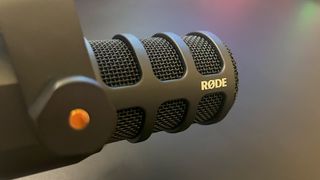
From most angles, the RODE PodMic USB appears as little more than a coat of black paint on the grille of the existing PodMic. That’s no bad thing, the PodMic was already a rather smart-looking microphone and if anything the new suit only heightens that. It’s a high-quality professional unit, simply put. There’s no flourish or pomp and certainly no gamer RGB. Moreover, it'll blend right into your setup if you invest in more of RODE's streaming gear, like the RODECaster Duo.
The PodMic USB retains the same form factor as the original, a stubby unit with an integrated swing mount ready to spin straight onto your mic arm. The microphone itself is just 12cm long, a nicely manageable size compared to other RODE dynamic microphones like the XDM-100 or the popular Shure SM7B which measures in at almost double that. Just like the original PodMic, the USB version is almost unbelievably heavy for its size. 900g is an outrageous weight for something this compact and while it certainly brings a quality vibe (you can’t question the build quality of something that solid), it also brings a few headaches when it comes to mic arm mounting.

The integrated ⅝” and ⅜” threads should mean the PodMic USB is pretty universal when it comes to stands, though I found that wasn’t always the case. Unsurprisingly branded options like RODE’s own PSA-1 or Elgato’s Wave Mic Arm were up to the task and confidently held the PodMic USB in place. However, cheaper alternatives I tried struggled with the weight of the PodMic USB in a number of positions, slumping down and looking rather sorry for themselves. Given there’s no tripod stand included in the box like with the RODE X XCM-50 you’ll need to invest in an arm if you don’t already have one, so make sure you don’t skimp on it.
Features
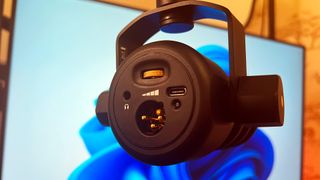
Around the back is what sets the PodMic USB apart from its predecessor, dual USB-C and XLR connectivity. Surprisingly though, despite debuting their Dual Connect combined XLR/USB-C port in the refreshed NT-1 earlier in the year, RODE has elected to keep the two ports separate on the PodMic USB. Each port gets its own space on the back panel like one of the best capture cards has for HDMI connections. Alongside them you'll find a 3.5mm headphone jack and a volume wheel for latency-free monitoring.
Similar to what comes with the XDM-100, RODE is kind enough to include a proprietary pop filter sleeve and a 3m USB-C cable. It’s nice to see these in the box rather than offered as paid extras and both have the same premium feel as the microphone itself. While the windshield does bulk out the microphone a little it’s considerably less intrusive than a traditional pop filter screen and the soft foam and flexible rubber skeleton perfectly slip over the PodMic USB with no fuss.
Performance
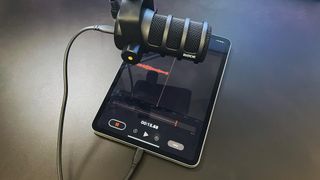
The original RODE PodMic delivered superb quality audio at a surprisingly low price point, it was so good in fact we awarded it a Highly Recommended badge. It meant RODE had set their own high bar but the USB adaptation simply builds off that pedigree with additions that make it an even more tantalising option for new creators.
For streamers and podcasters, the flexibility brought by that choice of either XLR or USB connection is excellent, allowing newcomers to start with the simplicity of USB before expanding into the realms of a full XLR setup. Plus that new 3.5mm headphone jack you can plug one of the best gaming headsets into is always welcome when it comes to listening out for alerts and Discord companions.
In general I found the PodMic USB still sounded wonderful too, with a crisp, full profile across a range of situations. Being a dynamic microphone you’ll benefit from a focused, directional pickup and the PodMic USB did a good job at ignoring unwanted noises from within the room. Vocals were unsurprisingly strong with a great level of presence and without wandering into over-the-top late night radio territory. The included windsock sleeve confidently rejected plosives without adding any noticeable muffle but despite an internal shock mount I did find the PodMic USB susceptible to desk bumps and knocks to the mic arm.

I say in general though because while what the PodMic USB pumps out did always sound great, bizarrely it didn’t always sound the same. You’ll need to choose between either the XLR or USB output, plugging in one disables the other, and I was surprised to find a difference in sound between the two outputs. It’s relatively subtle and only became particularly apparent at high volume, but to my ear the USB audio was the stronger overall choice with greater depth and a slightly more rounded overall profile.
This leg up over the XLR output is likely thanks to the onboard APHEX processing which excellently takes care of some basic EQ before sending it to your PC. It’s the same DSP that you’ll find in the RODECaster Pro II and to have this tech onboard is a big plus for the PodMic USB. You can take granular control of the sound with a range of tools in the RODE Central app or choose from a couple of simple presets. Either way it all felt very intuitive and even if you don’t know your Aural Exciter from your Big Bottom, a few minutes worth of trial and error is all you need.
The new PodMic’s USB connection also makes it a great option for creators with a more mobile setup, as long as you’ve got the right cables that is. When connected to my iPad Pro using the supplied RODE USB-C to USB-C cable it performed perfectly, instantly recognising and delivering the same high level of audio that I found with my PC. RODE offers a couple of their own apps for recording (including a very stripped down version of RODE Central) but the PodMic USB worked as a microphone across any app I tried. My iPhone was less fortunate however, you’ll need an Apple MFI Certified cable which, bizarrely, the official USB-C to Lightning cable isn’t.
Should you buy the RODE PodMic USB?
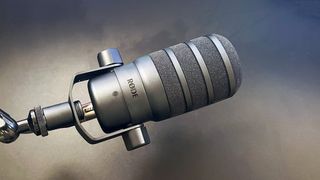
RODE has an incredible reputation in audio for a reason and the new PodMic USB is another strong showing from the Australian brand. This is a high quality dynamic microphone and the choice of XLR or USB output makes it a versatile option for streamers, podcasters or even home workers in a string of video calls.
However unlike the aggressively priced XLR-only PodMic, the PodMic USB’s £199/$199 price tag isn’t something to boast about and sits it alongside a wealth of competition and above comparable options like RODE’s own USB only XDM-100. There’s no doubting you’re getting what you pay for though, and if flexibility is front of mind, the PodMic USB could be the answer.
How we tested the RODE PodMic USB
I connected the RODE PodMic USB to my PC and used it for live streaming and specific audio testing with both its XLR and USB outputs. In XLR mode it was connected to the RODECaster Duo and sampled with processing both on and off, in USB mode it was connected with the supplied USB-C cable. I also tested it across iOS mobile devices attempting to use the included USB-C cable and an official Apple USB-C to Lightning cable.
If you'd like to hear more about our testing methods, take a look at our hardware policy
Want to hear about more streaming gear? Check out the best webcams, the best green screen, and the best ring lights for streaming.
Alex is a streamer who has been creating gaming content for over a decade, streaming on Twitch regularly across the last five years. With a degree in film and a background in sports media, you'll find him jumping between 60,000 seat stadiums and his Animal Crossing island (where he's growing pears, in case you were wondering).

Manor Lords breaks a Steam city-builder and strategy game record, beating Civilization 6 and Cities: Skylines as it sells 1 million copies just one day after release

Borderlands release date, cast, and everything else you need to know about the new video game movie

Escape From Tarkov devs reverse course on $250 PvE mode, promise it'll be free for all when the game exits beta - but its early access is still paywalled
